Project: Analyzing Motivation and Empowerment Strategies at Starbucks
VerifiedAdded on 2020/06/03
|10
|2200
|32
Project
AI Summary
This project is a comprehensive analysis of Starbucks' motivation and empowerment strategies, focusing on their impact on organizational behavior and business communications. The project begins with a literature review exploring various motivation and empowerment theories, including those relevant to Starbucks' practices. It then presents a detailed project plan outlining the objectives, justifications, and expected outcomes. The project aims to understand the importance of motivation and empowerment at Starbucks, evaluate the effectiveness of its current strategies, and recommend improvements. The methodology section describes the secondary data collection approach and qualitative data analysis. The project highlights the significance of employee motivation for enhancing productivity, quality, and customer service, and the role of leadership in fostering a positive work environment. The project also discusses the benefits of empowerment in terms of employee morale, innovation, and overall organizational success. The project concludes with a list of references used for the research and analysis. The project is intended to provide insights into Starbucks' approach to managing its workforce and improving its business performance.
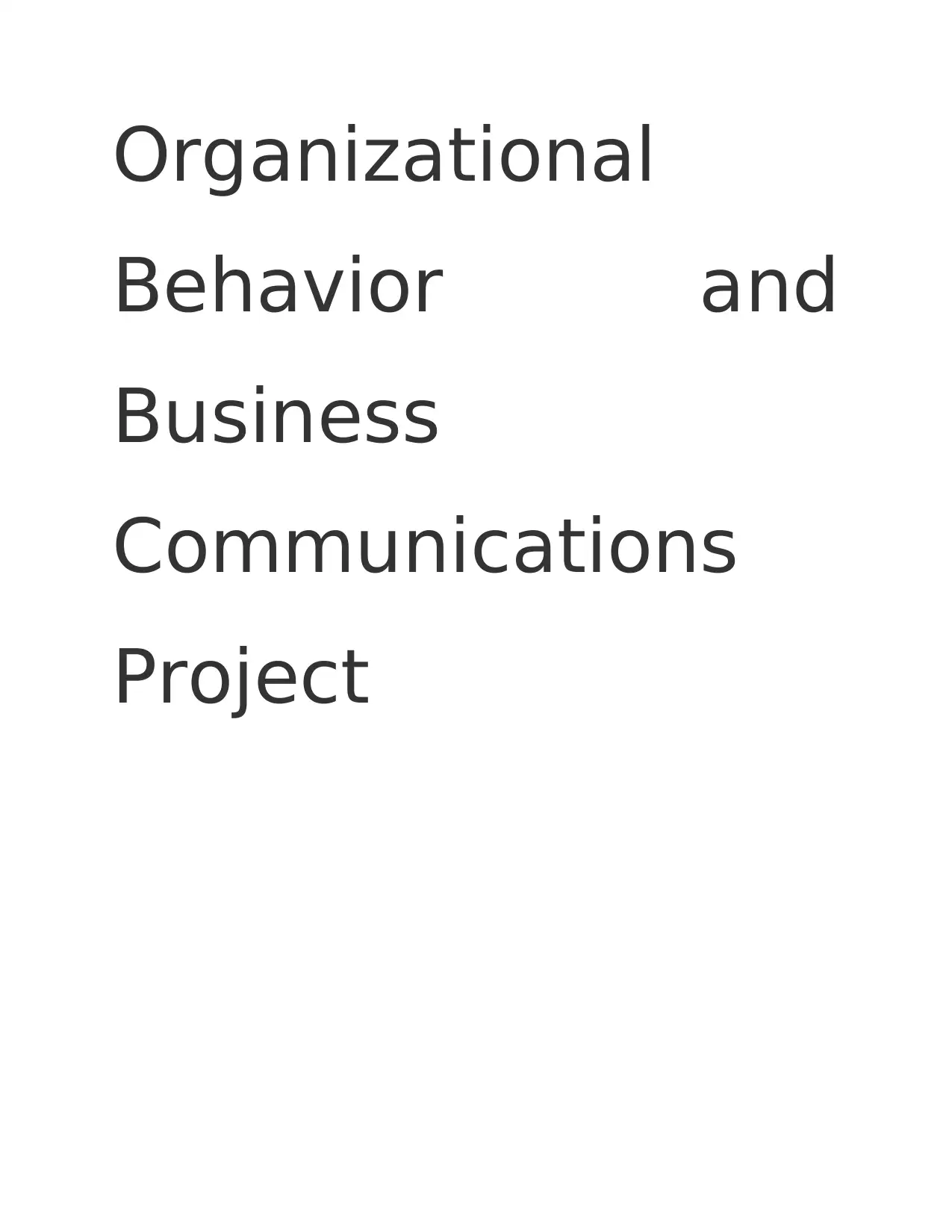
Organizational
Behavior and
Business
Communications
Project
Behavior and
Business
Communications
Project
Paraphrase This Document
Need a fresh take? Get an instant paraphrase of this document with our AI Paraphraser
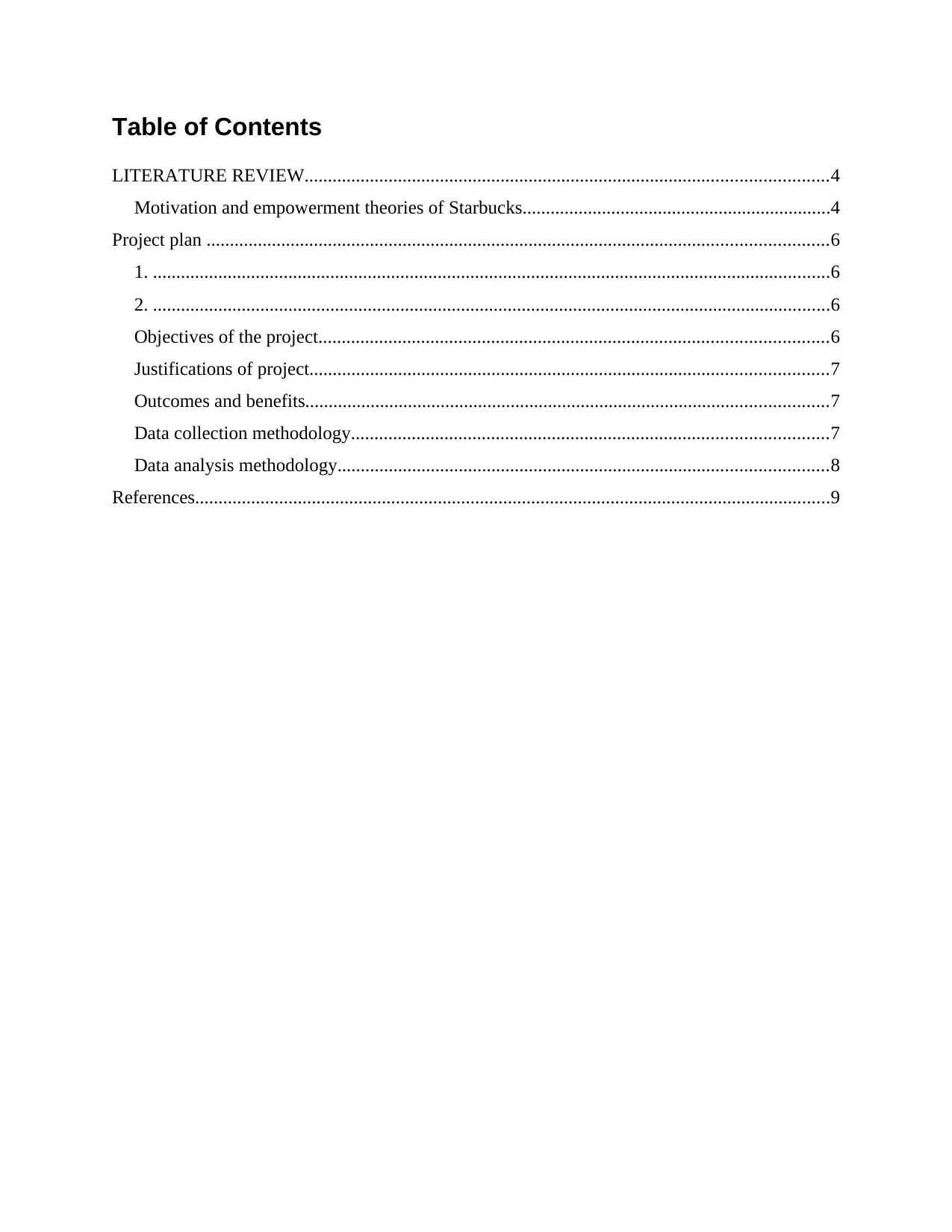
Table of Contents
LITERATURE REVIEW................................................................................................................4
Motivation and empowerment theories of Starbucks..................................................................4
Project plan .....................................................................................................................................6
1. .................................................................................................................................................6
2. .................................................................................................................................................6
Objectives of the project.............................................................................................................6
Justifications of project...............................................................................................................7
Outcomes and benefits................................................................................................................7
Data collection methodology......................................................................................................7
Data analysis methodology.........................................................................................................8
References........................................................................................................................................9
LITERATURE REVIEW................................................................................................................4
Motivation and empowerment theories of Starbucks..................................................................4
Project plan .....................................................................................................................................6
1. .................................................................................................................................................6
2. .................................................................................................................................................6
Objectives of the project.............................................................................................................6
Justifications of project...............................................................................................................7
Outcomes and benefits................................................................................................................7
Data collection methodology......................................................................................................7
Data analysis methodology.........................................................................................................8
References........................................................................................................................................9

⊘ This is a preview!⊘
Do you want full access?
Subscribe today to unlock all pages.

Trusted by 1+ million students worldwide
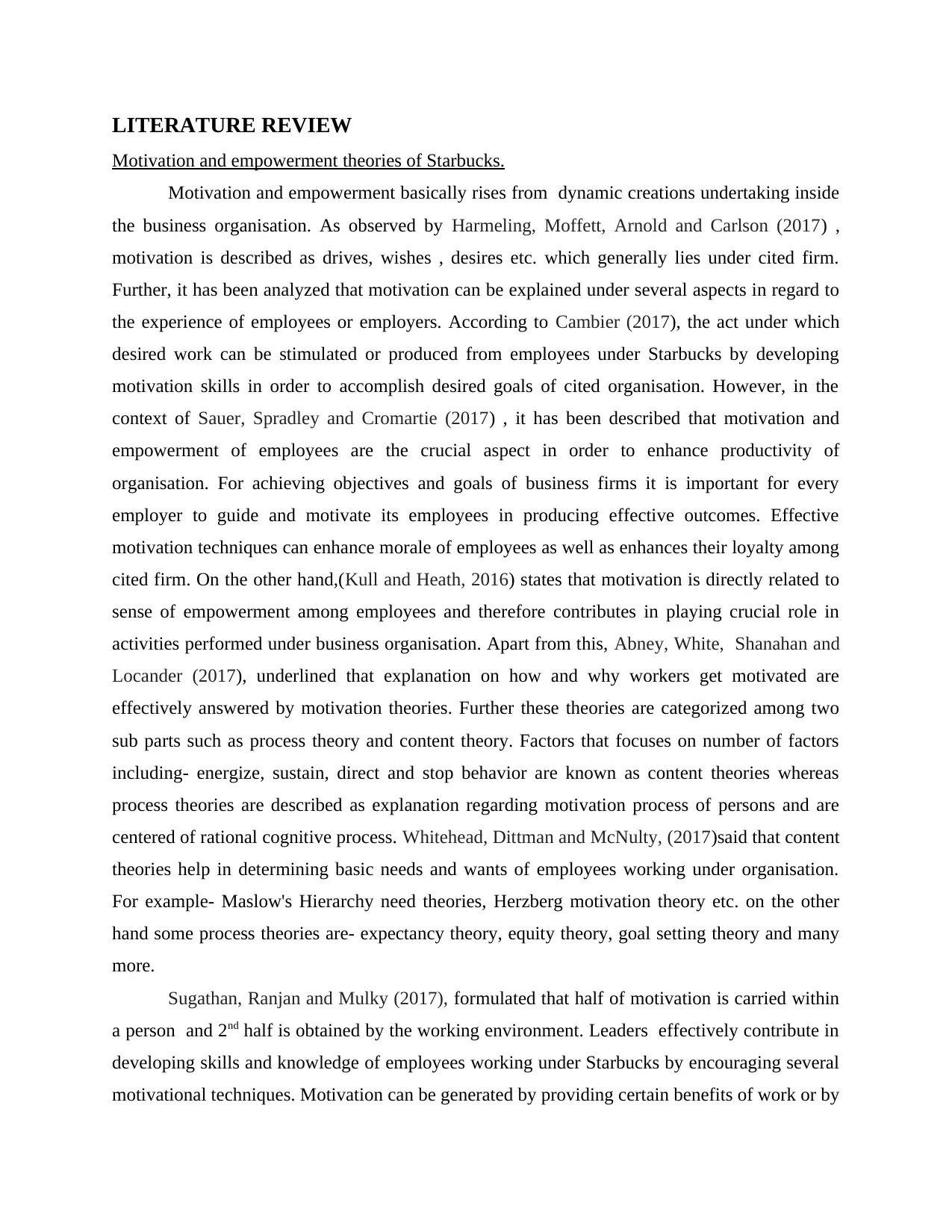
LITERATURE REVIEW
Motivation and empowerment theories of Starbucks.
Motivation and empowerment basically rises from dynamic creations undertaking inside
the business organisation. As observed by Harmeling, Moffett, Arnold and Carlson (2017) ,
motivation is described as drives, wishes , desires etc. which generally lies under cited firm.
Further, it has been analyzed that motivation can be explained under several aspects in regard to
the experience of employees or employers. According to Cambier (2017), the act under which
desired work can be stimulated or produced from employees under Starbucks by developing
motivation skills in order to accomplish desired goals of cited organisation. However, in the
context of Sauer, Spradley and Cromartie (2017) , it has been described that motivation and
empowerment of employees are the crucial aspect in order to enhance productivity of
organisation. For achieving objectives and goals of business firms it is important for every
employer to guide and motivate its employees in producing effective outcomes. Effective
motivation techniques can enhance morale of employees as well as enhances their loyalty among
cited firm. On the other hand,(Kull and Heath, 2016) states that motivation is directly related to
sense of empowerment among employees and therefore contributes in playing crucial role in
activities performed under business organisation. Apart from this, Abney, White, Shanahan and
Locander (2017), underlined that explanation on how and why workers get motivated are
effectively answered by motivation theories. Further these theories are categorized among two
sub parts such as process theory and content theory. Factors that focuses on number of factors
including- energize, sustain, direct and stop behavior are known as content theories whereas
process theories are described as explanation regarding motivation process of persons and are
centered of rational cognitive process. Whitehead, Dittman and McNulty, (2017)said that content
theories help in determining basic needs and wants of employees working under organisation.
For example- Maslow's Hierarchy need theories, Herzberg motivation theory etc. on the other
hand some process theories are- expectancy theory, equity theory, goal setting theory and many
more.
Sugathan, Ranjan and Mulky (2017), formulated that half of motivation is carried within
a person and 2nd half is obtained by the working environment. Leaders effectively contribute in
developing skills and knowledge of employees working under Starbucks by encouraging several
motivational techniques. Motivation can be generated by providing certain benefits of work or by
Motivation and empowerment theories of Starbucks.
Motivation and empowerment basically rises from dynamic creations undertaking inside
the business organisation. As observed by Harmeling, Moffett, Arnold and Carlson (2017) ,
motivation is described as drives, wishes , desires etc. which generally lies under cited firm.
Further, it has been analyzed that motivation can be explained under several aspects in regard to
the experience of employees or employers. According to Cambier (2017), the act under which
desired work can be stimulated or produced from employees under Starbucks by developing
motivation skills in order to accomplish desired goals of cited organisation. However, in the
context of Sauer, Spradley and Cromartie (2017) , it has been described that motivation and
empowerment of employees are the crucial aspect in order to enhance productivity of
organisation. For achieving objectives and goals of business firms it is important for every
employer to guide and motivate its employees in producing effective outcomes. Effective
motivation techniques can enhance morale of employees as well as enhances their loyalty among
cited firm. On the other hand,(Kull and Heath, 2016) states that motivation is directly related to
sense of empowerment among employees and therefore contributes in playing crucial role in
activities performed under business organisation. Apart from this, Abney, White, Shanahan and
Locander (2017), underlined that explanation on how and why workers get motivated are
effectively answered by motivation theories. Further these theories are categorized among two
sub parts such as process theory and content theory. Factors that focuses on number of factors
including- energize, sustain, direct and stop behavior are known as content theories whereas
process theories are described as explanation regarding motivation process of persons and are
centered of rational cognitive process. Whitehead, Dittman and McNulty, (2017)said that content
theories help in determining basic needs and wants of employees working under organisation.
For example- Maslow's Hierarchy need theories, Herzberg motivation theory etc. on the other
hand some process theories are- expectancy theory, equity theory, goal setting theory and many
more.
Sugathan, Ranjan and Mulky (2017), formulated that half of motivation is carried within
a person and 2nd half is obtained by the working environment. Leaders effectively contribute in
developing skills and knowledge of employees working under Starbucks by encouraging several
motivational techniques. Motivation can be generated by providing certain benefits of work or by
Paraphrase This Document
Need a fresh take? Get an instant paraphrase of this document with our AI Paraphraser
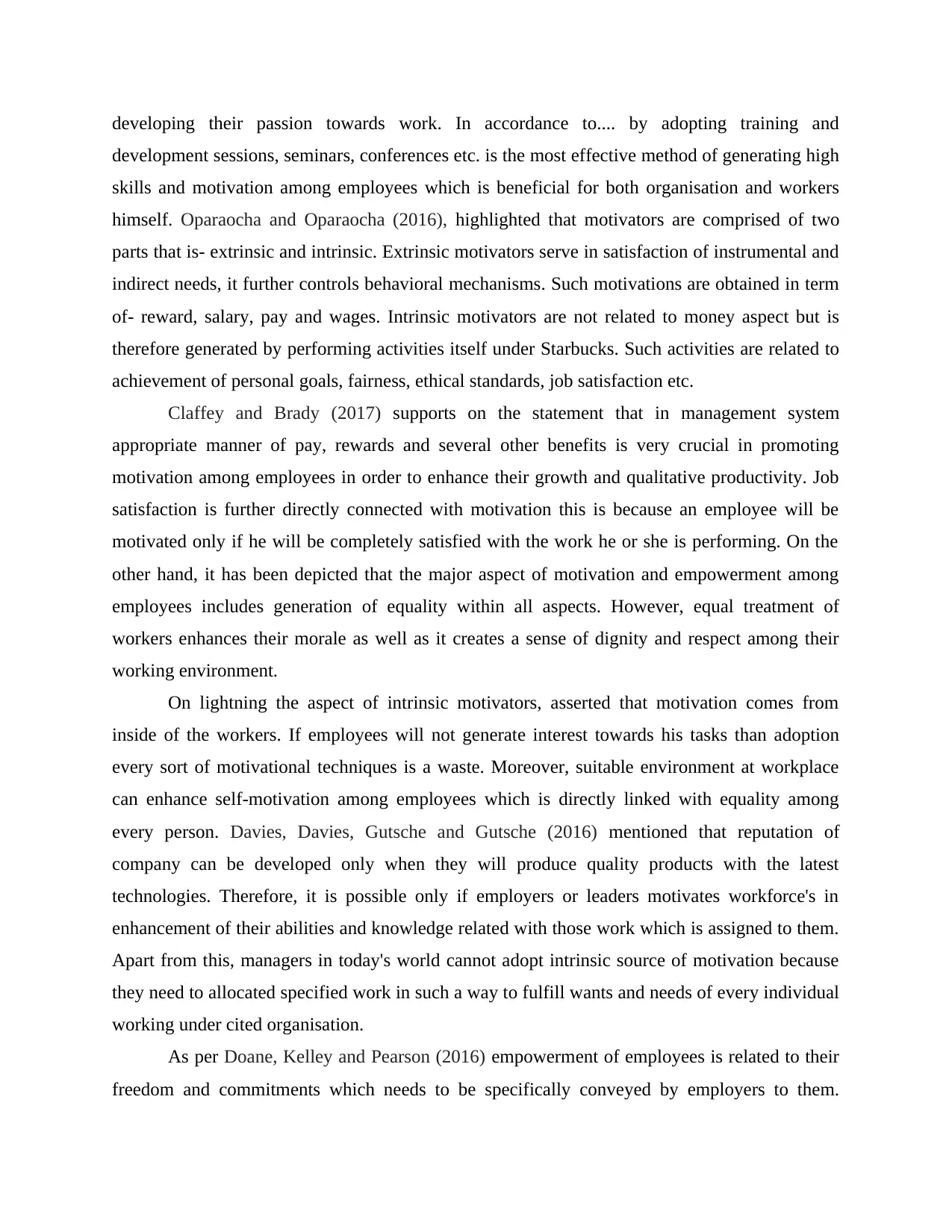
developing their passion towards work. In accordance to.... by adopting training and
development sessions, seminars, conferences etc. is the most effective method of generating high
skills and motivation among employees which is beneficial for both organisation and workers
himself. Oparaocha and Oparaocha (2016), highlighted that motivators are comprised of two
parts that is- extrinsic and intrinsic. Extrinsic motivators serve in satisfaction of instrumental and
indirect needs, it further controls behavioral mechanisms. Such motivations are obtained in term
of- reward, salary, pay and wages. Intrinsic motivators are not related to money aspect but is
therefore generated by performing activities itself under Starbucks. Such activities are related to
achievement of personal goals, fairness, ethical standards, job satisfaction etc.
Claffey and Brady (2017) supports on the statement that in management system
appropriate manner of pay, rewards and several other benefits is very crucial in promoting
motivation among employees in order to enhance their growth and qualitative productivity. Job
satisfaction is further directly connected with motivation this is because an employee will be
motivated only if he will be completely satisfied with the work he or she is performing. On the
other hand, it has been depicted that the major aspect of motivation and empowerment among
employees includes generation of equality within all aspects. However, equal treatment of
workers enhances their morale as well as it creates a sense of dignity and respect among their
working environment.
On lightning the aspect of intrinsic motivators, asserted that motivation comes from
inside of the workers. If employees will not generate interest towards his tasks than adoption
every sort of motivational techniques is a waste. Moreover, suitable environment at workplace
can enhance self-motivation among employees which is directly linked with equality among
every person. Davies, Davies, Gutsche and Gutsche (2016) mentioned that reputation of
company can be developed only when they will produce quality products with the latest
technologies. Therefore, it is possible only if employers or leaders motivates workforce's in
enhancement of their abilities and knowledge related with those work which is assigned to them.
Apart from this, managers in today's world cannot adopt intrinsic source of motivation because
they need to allocated specified work in such a way to fulfill wants and needs of every individual
working under cited organisation.
As per Doane, Kelley and Pearson (2016) empowerment of employees is related to their
freedom and commitments which needs to be specifically conveyed by employers to them.
development sessions, seminars, conferences etc. is the most effective method of generating high
skills and motivation among employees which is beneficial for both organisation and workers
himself. Oparaocha and Oparaocha (2016), highlighted that motivators are comprised of two
parts that is- extrinsic and intrinsic. Extrinsic motivators serve in satisfaction of instrumental and
indirect needs, it further controls behavioral mechanisms. Such motivations are obtained in term
of- reward, salary, pay and wages. Intrinsic motivators are not related to money aspect but is
therefore generated by performing activities itself under Starbucks. Such activities are related to
achievement of personal goals, fairness, ethical standards, job satisfaction etc.
Claffey and Brady (2017) supports on the statement that in management system
appropriate manner of pay, rewards and several other benefits is very crucial in promoting
motivation among employees in order to enhance their growth and qualitative productivity. Job
satisfaction is further directly connected with motivation this is because an employee will be
motivated only if he will be completely satisfied with the work he or she is performing. On the
other hand, it has been depicted that the major aspect of motivation and empowerment among
employees includes generation of equality within all aspects. However, equal treatment of
workers enhances their morale as well as it creates a sense of dignity and respect among their
working environment.
On lightning the aspect of intrinsic motivators, asserted that motivation comes from
inside of the workers. If employees will not generate interest towards his tasks than adoption
every sort of motivational techniques is a waste. Moreover, suitable environment at workplace
can enhance self-motivation among employees which is directly linked with equality among
every person. Davies, Davies, Gutsche and Gutsche (2016) mentioned that reputation of
company can be developed only when they will produce quality products with the latest
technologies. Therefore, it is possible only if employers or leaders motivates workforce's in
enhancement of their abilities and knowledge related with those work which is assigned to them.
Apart from this, managers in today's world cannot adopt intrinsic source of motivation because
they need to allocated specified work in such a way to fulfill wants and needs of every individual
working under cited organisation.
As per Doane, Kelley and Pearson (2016) empowerment of employees is related to their
freedom and commitments which needs to be specifically conveyed by employers to them.
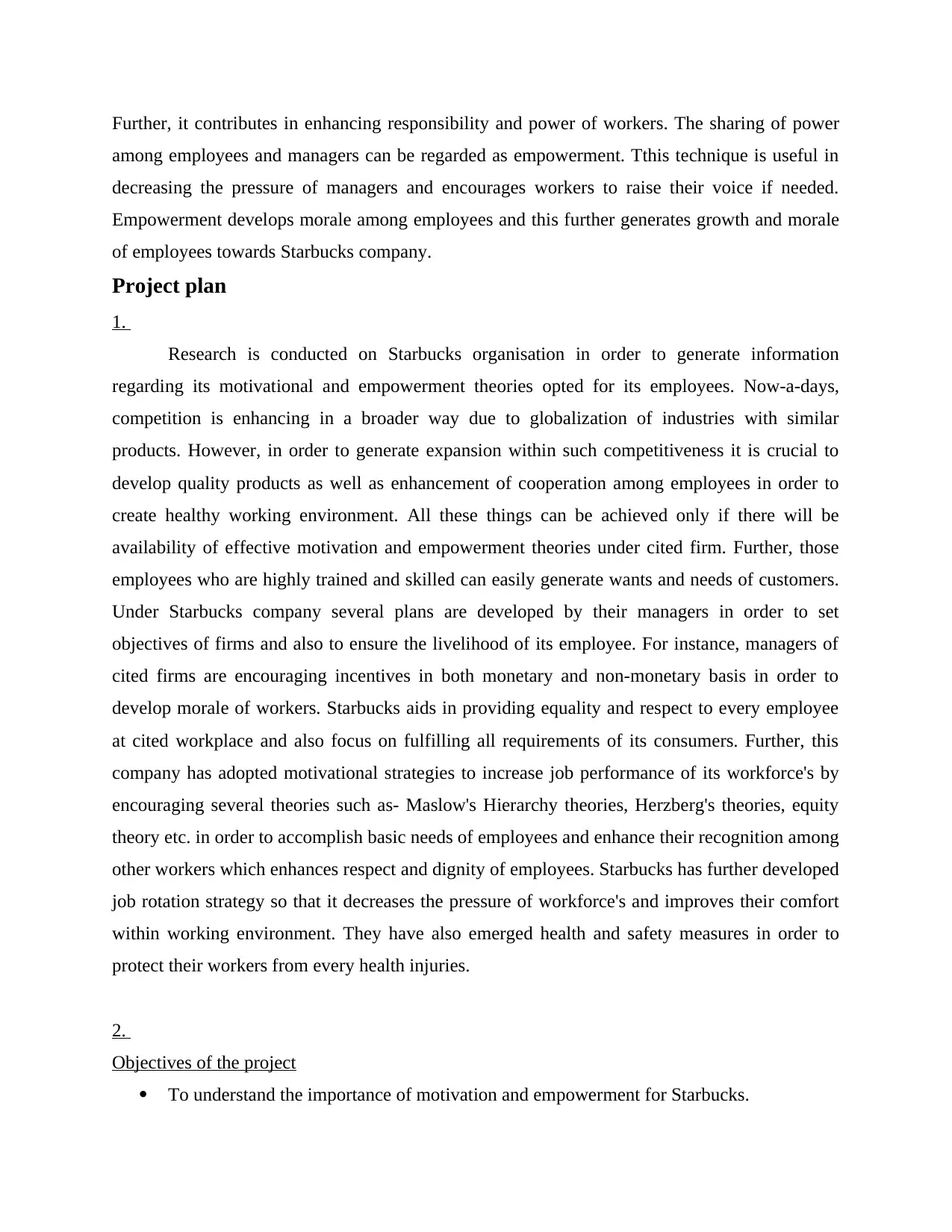
Further, it contributes in enhancing responsibility and power of workers. The sharing of power
among employees and managers can be regarded as empowerment. Tthis technique is useful in
decreasing the pressure of managers and encourages workers to raise their voice if needed.
Empowerment develops morale among employees and this further generates growth and morale
of employees towards Starbucks company.
Project plan
1.
Research is conducted on Starbucks organisation in order to generate information
regarding its motivational and empowerment theories opted for its employees. Now-a-days,
competition is enhancing in a broader way due to globalization of industries with similar
products. However, in order to generate expansion within such competitiveness it is crucial to
develop quality products as well as enhancement of cooperation among employees in order to
create healthy working environment. All these things can be achieved only if there will be
availability of effective motivation and empowerment theories under cited firm. Further, those
employees who are highly trained and skilled can easily generate wants and needs of customers.
Under Starbucks company several plans are developed by their managers in order to set
objectives of firms and also to ensure the livelihood of its employee. For instance, managers of
cited firms are encouraging incentives in both monetary and non-monetary basis in order to
develop morale of workers. Starbucks aids in providing equality and respect to every employee
at cited workplace and also focus on fulfilling all requirements of its consumers. Further, this
company has adopted motivational strategies to increase job performance of its workforce's by
encouraging several theories such as- Maslow's Hierarchy theories, Herzberg's theories, equity
theory etc. in order to accomplish basic needs of employees and enhance their recognition among
other workers which enhances respect and dignity of employees. Starbucks has further developed
job rotation strategy so that it decreases the pressure of workforce's and improves their comfort
within working environment. They have also emerged health and safety measures in order to
protect their workers from every health injuries.
2.
Objectives of the project
To understand the importance of motivation and empowerment for Starbucks.
among employees and managers can be regarded as empowerment. Tthis technique is useful in
decreasing the pressure of managers and encourages workers to raise their voice if needed.
Empowerment develops morale among employees and this further generates growth and morale
of employees towards Starbucks company.
Project plan
1.
Research is conducted on Starbucks organisation in order to generate information
regarding its motivational and empowerment theories opted for its employees. Now-a-days,
competition is enhancing in a broader way due to globalization of industries with similar
products. However, in order to generate expansion within such competitiveness it is crucial to
develop quality products as well as enhancement of cooperation among employees in order to
create healthy working environment. All these things can be achieved only if there will be
availability of effective motivation and empowerment theories under cited firm. Further, those
employees who are highly trained and skilled can easily generate wants and needs of customers.
Under Starbucks company several plans are developed by their managers in order to set
objectives of firms and also to ensure the livelihood of its employee. For instance, managers of
cited firms are encouraging incentives in both monetary and non-monetary basis in order to
develop morale of workers. Starbucks aids in providing equality and respect to every employee
at cited workplace and also focus on fulfilling all requirements of its consumers. Further, this
company has adopted motivational strategies to increase job performance of its workforce's by
encouraging several theories such as- Maslow's Hierarchy theories, Herzberg's theories, equity
theory etc. in order to accomplish basic needs of employees and enhance their recognition among
other workers which enhances respect and dignity of employees. Starbucks has further developed
job rotation strategy so that it decreases the pressure of workforce's and improves their comfort
within working environment. They have also emerged health and safety measures in order to
protect their workers from every health injuries.
2.
Objectives of the project
To understand the importance of motivation and empowerment for Starbucks.
⊘ This is a preview!⊘
Do you want full access?
Subscribe today to unlock all pages.

Trusted by 1+ million students worldwide
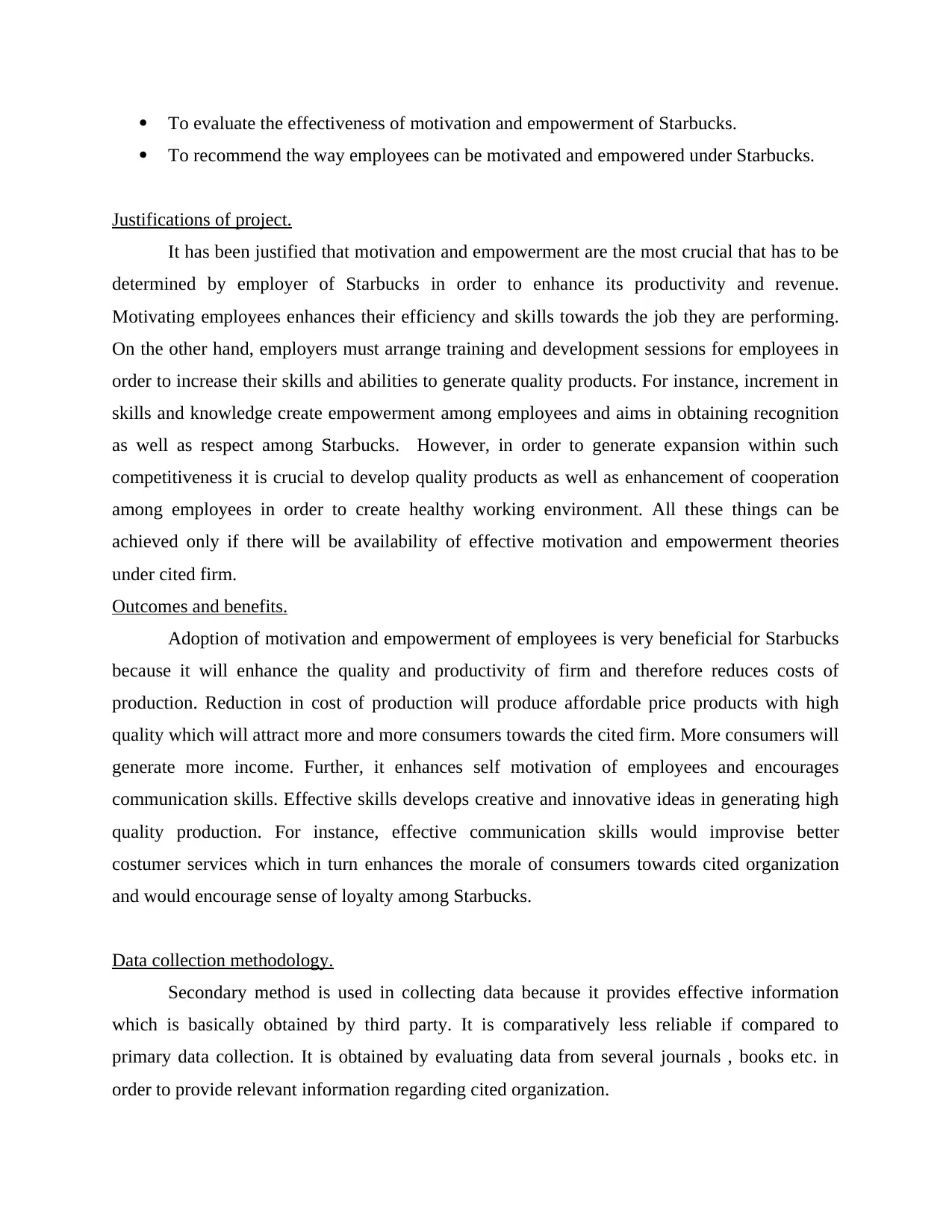
To evaluate the effectiveness of motivation and empowerment of Starbucks.
To recommend the way employees can be motivated and empowered under Starbucks.
Justifications of project.
It has been justified that motivation and empowerment are the most crucial that has to be
determined by employer of Starbucks in order to enhance its productivity and revenue.
Motivating employees enhances their efficiency and skills towards the job they are performing.
On the other hand, employers must arrange training and development sessions for employees in
order to increase their skills and abilities to generate quality products. For instance, increment in
skills and knowledge create empowerment among employees and aims in obtaining recognition
as well as respect among Starbucks. However, in order to generate expansion within such
competitiveness it is crucial to develop quality products as well as enhancement of cooperation
among employees in order to create healthy working environment. All these things can be
achieved only if there will be availability of effective motivation and empowerment theories
under cited firm.
Outcomes and benefits.
Adoption of motivation and empowerment of employees is very beneficial for Starbucks
because it will enhance the quality and productivity of firm and therefore reduces costs of
production. Reduction in cost of production will produce affordable price products with high
quality which will attract more and more consumers towards the cited firm. More consumers will
generate more income. Further, it enhances self motivation of employees and encourages
communication skills. Effective skills develops creative and innovative ideas in generating high
quality production. For instance, effective communication skills would improvise better
costumer services which in turn enhances the morale of consumers towards cited organization
and would encourage sense of loyalty among Starbucks.
Data collection methodology.
Secondary method is used in collecting data because it provides effective information
which is basically obtained by third party. It is comparatively less reliable if compared to
primary data collection. It is obtained by evaluating data from several journals , books etc. in
order to provide relevant information regarding cited organization.
To recommend the way employees can be motivated and empowered under Starbucks.
Justifications of project.
It has been justified that motivation and empowerment are the most crucial that has to be
determined by employer of Starbucks in order to enhance its productivity and revenue.
Motivating employees enhances their efficiency and skills towards the job they are performing.
On the other hand, employers must arrange training and development sessions for employees in
order to increase their skills and abilities to generate quality products. For instance, increment in
skills and knowledge create empowerment among employees and aims in obtaining recognition
as well as respect among Starbucks. However, in order to generate expansion within such
competitiveness it is crucial to develop quality products as well as enhancement of cooperation
among employees in order to create healthy working environment. All these things can be
achieved only if there will be availability of effective motivation and empowerment theories
under cited firm.
Outcomes and benefits.
Adoption of motivation and empowerment of employees is very beneficial for Starbucks
because it will enhance the quality and productivity of firm and therefore reduces costs of
production. Reduction in cost of production will produce affordable price products with high
quality which will attract more and more consumers towards the cited firm. More consumers will
generate more income. Further, it enhances self motivation of employees and encourages
communication skills. Effective skills develops creative and innovative ideas in generating high
quality production. For instance, effective communication skills would improvise better
costumer services which in turn enhances the morale of consumers towards cited organization
and would encourage sense of loyalty among Starbucks.
Data collection methodology.
Secondary method is used in collecting data because it provides effective information
which is basically obtained by third party. It is comparatively less reliable if compared to
primary data collection. It is obtained by evaluating data from several journals , books etc. in
order to provide relevant information regarding cited organization.
Paraphrase This Document
Need a fresh take? Get an instant paraphrase of this document with our AI Paraphraser
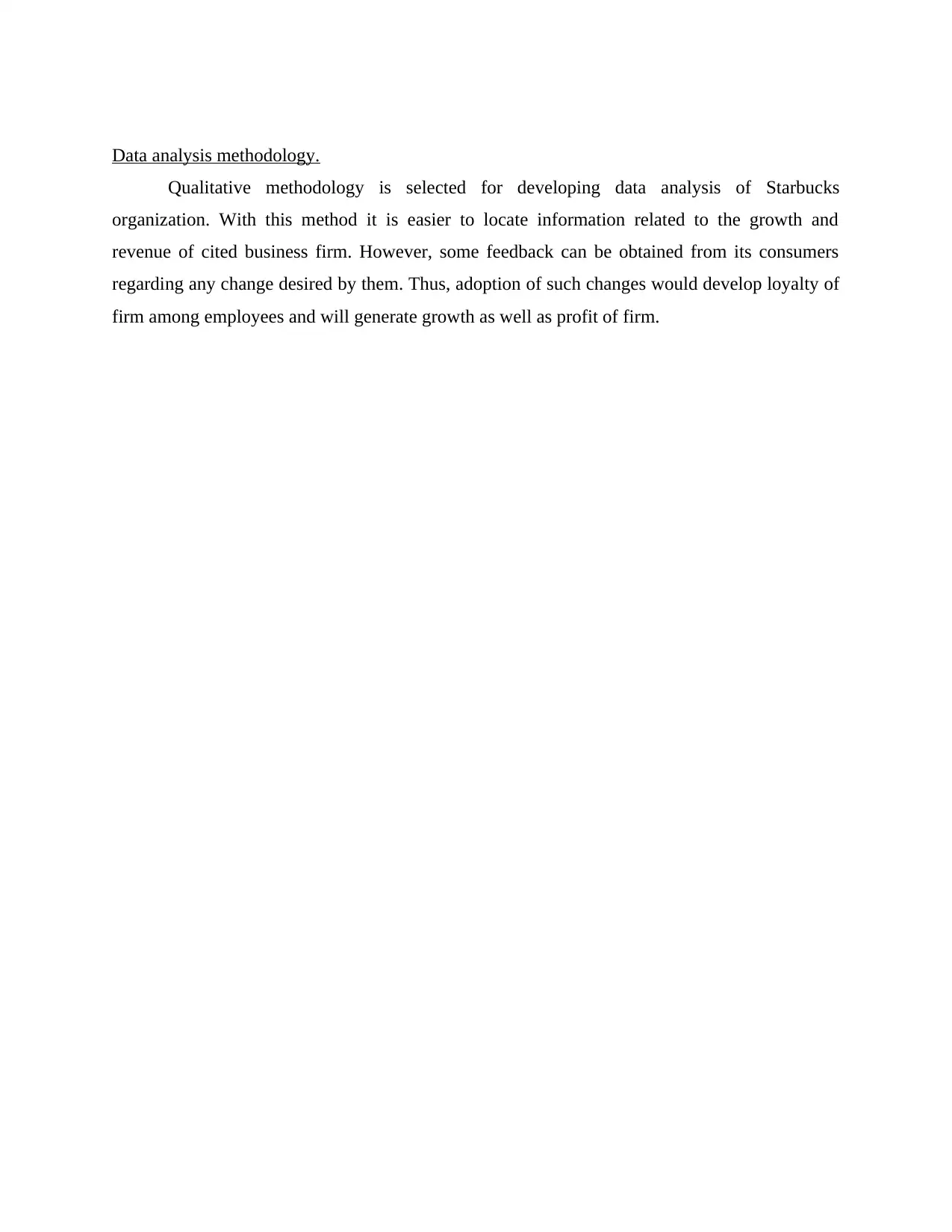
Data analysis methodology.
Qualitative methodology is selected for developing data analysis of Starbucks
organization. With this method it is easier to locate information related to the growth and
revenue of cited business firm. However, some feedback can be obtained from its consumers
regarding any change desired by them. Thus, adoption of such changes would develop loyalty of
firm among employees and will generate growth as well as profit of firm.
Qualitative methodology is selected for developing data analysis of Starbucks
organization. With this method it is easier to locate information related to the growth and
revenue of cited business firm. However, some feedback can be obtained from its consumers
regarding any change desired by them. Thus, adoption of such changes would develop loyalty of
firm among employees and will generate growth as well as profit of firm.
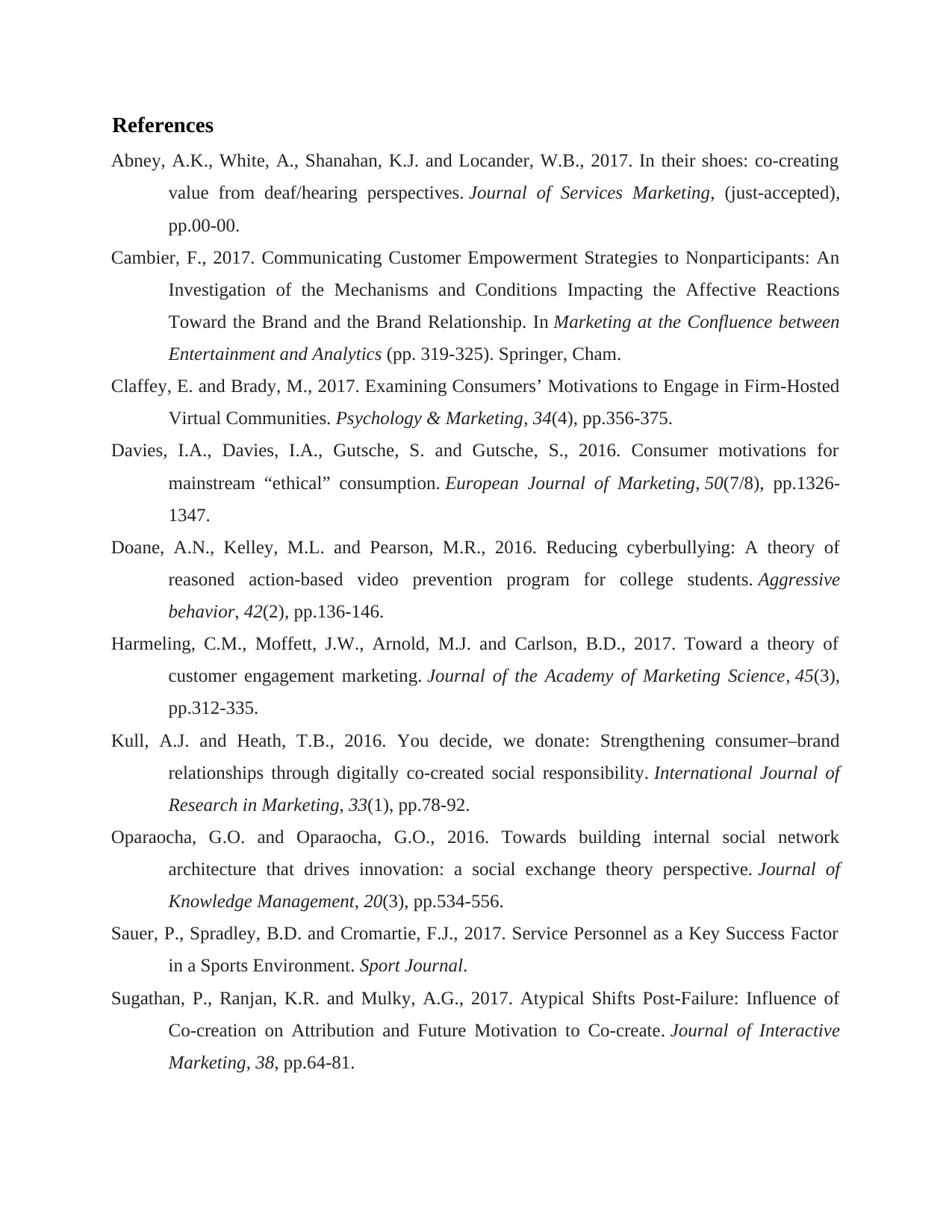
References
Abney, A.K., White, A., Shanahan, K.J. and Locander, W.B., 2017. In their shoes: co-creating
value from deaf/hearing perspectives. Journal of Services Marketing, (just-accepted),
pp.00-00.
Cambier, F., 2017. Communicating Customer Empowerment Strategies to Nonparticipants: An
Investigation of the Mechanisms and Conditions Impacting the Affective Reactions
Toward the Brand and the Brand Relationship. In Marketing at the Confluence between
Entertainment and Analytics (pp. 319-325). Springer, Cham.
Claffey, E. and Brady, M., 2017. Examining Consumers’ Motivations to Engage in Firm‐Hosted
Virtual Communities. Psychology & Marketing, 34(4), pp.356-375.
Davies, I.A., Davies, I.A., Gutsche, S. and Gutsche, S., 2016. Consumer motivations for
mainstream “ethical” consumption. European Journal of Marketing, 50(7/8), pp.1326-
1347.
Doane, A.N., Kelley, M.L. and Pearson, M.R., 2016. Reducing cyberbullying: A theory of
reasoned action‐based video prevention program for college students. Aggressive
behavior, 42(2), pp.136-146.
Harmeling, C.M., Moffett, J.W., Arnold, M.J. and Carlson, B.D., 2017. Toward a theory of
customer engagement marketing. Journal of the Academy of Marketing Science, 45(3),
pp.312-335.
Kull, A.J. and Heath, T.B., 2016. You decide, we donate: Strengthening consumer–brand
relationships through digitally co-created social responsibility. International Journal of
Research in Marketing, 33(1), pp.78-92.
Oparaocha, G.O. and Oparaocha, G.O., 2016. Towards building internal social network
architecture that drives innovation: a social exchange theory perspective. Journal of
Knowledge Management, 20(3), pp.534-556.
Sauer, P., Spradley, B.D. and Cromartie, F.J., 2017. Service Personnel as a Key Success Factor
in a Sports Environment. Sport Journal.
Sugathan, P., Ranjan, K.R. and Mulky, A.G., 2017. Atypical Shifts Post-Failure: Influence of
Co-creation on Attribution and Future Motivation to Co-create. Journal of Interactive
Marketing, 38, pp.64-81.
Abney, A.K., White, A., Shanahan, K.J. and Locander, W.B., 2017. In their shoes: co-creating
value from deaf/hearing perspectives. Journal of Services Marketing, (just-accepted),
pp.00-00.
Cambier, F., 2017. Communicating Customer Empowerment Strategies to Nonparticipants: An
Investigation of the Mechanisms and Conditions Impacting the Affective Reactions
Toward the Brand and the Brand Relationship. In Marketing at the Confluence between
Entertainment and Analytics (pp. 319-325). Springer, Cham.
Claffey, E. and Brady, M., 2017. Examining Consumers’ Motivations to Engage in Firm‐Hosted
Virtual Communities. Psychology & Marketing, 34(4), pp.356-375.
Davies, I.A., Davies, I.A., Gutsche, S. and Gutsche, S., 2016. Consumer motivations for
mainstream “ethical” consumption. European Journal of Marketing, 50(7/8), pp.1326-
1347.
Doane, A.N., Kelley, M.L. and Pearson, M.R., 2016. Reducing cyberbullying: A theory of
reasoned action‐based video prevention program for college students. Aggressive
behavior, 42(2), pp.136-146.
Harmeling, C.M., Moffett, J.W., Arnold, M.J. and Carlson, B.D., 2017. Toward a theory of
customer engagement marketing. Journal of the Academy of Marketing Science, 45(3),
pp.312-335.
Kull, A.J. and Heath, T.B., 2016. You decide, we donate: Strengthening consumer–brand
relationships through digitally co-created social responsibility. International Journal of
Research in Marketing, 33(1), pp.78-92.
Oparaocha, G.O. and Oparaocha, G.O., 2016. Towards building internal social network
architecture that drives innovation: a social exchange theory perspective. Journal of
Knowledge Management, 20(3), pp.534-556.
Sauer, P., Spradley, B.D. and Cromartie, F.J., 2017. Service Personnel as a Key Success Factor
in a Sports Environment. Sport Journal.
Sugathan, P., Ranjan, K.R. and Mulky, A.G., 2017. Atypical Shifts Post-Failure: Influence of
Co-creation on Attribution and Future Motivation to Co-create. Journal of Interactive
Marketing, 38, pp.64-81.
⊘ This is a preview!⊘
Do you want full access?
Subscribe today to unlock all pages.

Trusted by 1+ million students worldwide
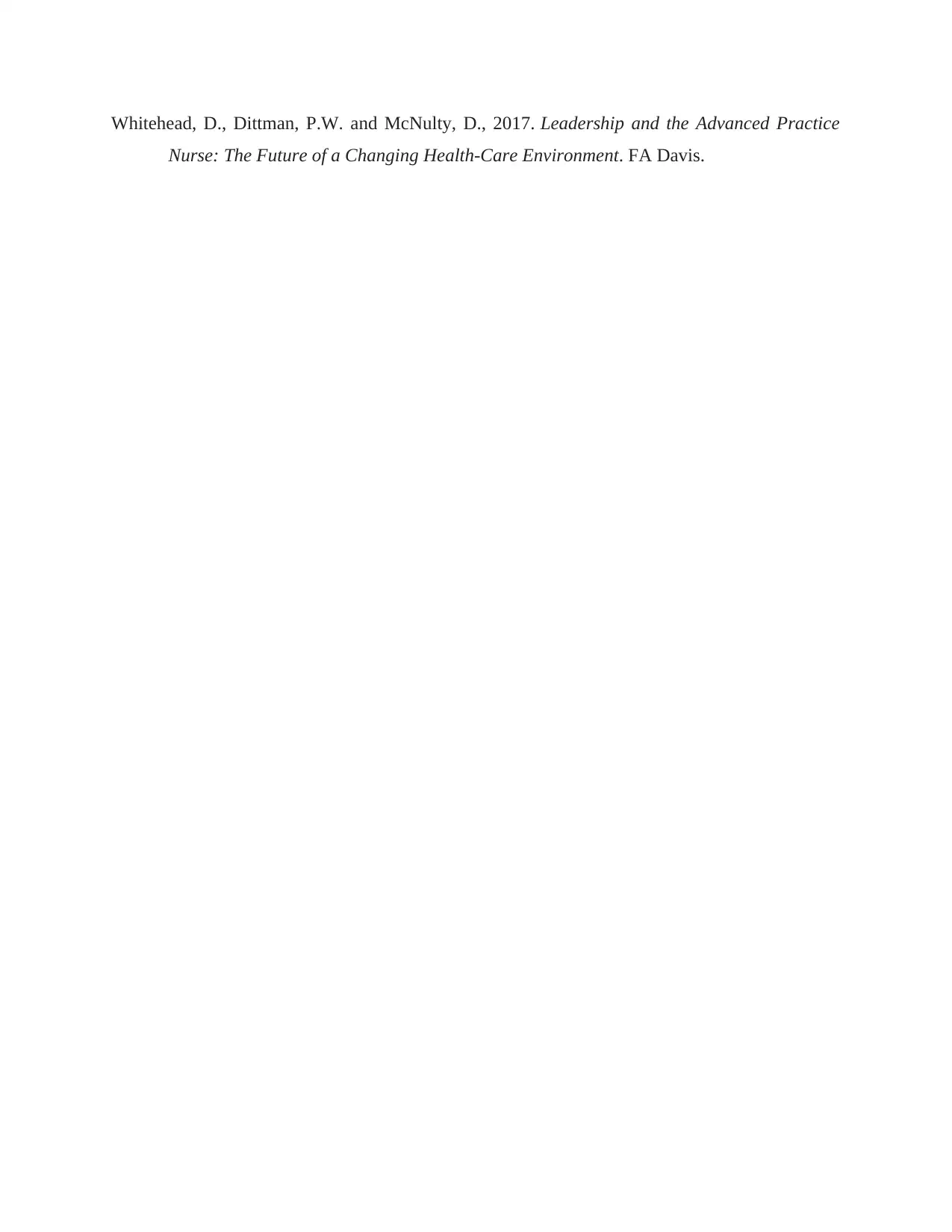
Whitehead, D., Dittman, P.W. and McNulty, D., 2017. Leadership and the Advanced Practice
Nurse: The Future of a Changing Health-Care Environment. FA Davis.
Nurse: The Future of a Changing Health-Care Environment. FA Davis.
1 out of 10
Related Documents
Your All-in-One AI-Powered Toolkit for Academic Success.
+13062052269
info@desklib.com
Available 24*7 on WhatsApp / Email
![[object Object]](/_next/static/media/star-bottom.7253800d.svg)
Unlock your academic potential
Copyright © 2020–2025 A2Z Services. All Rights Reserved. Developed and managed by ZUCOL.




